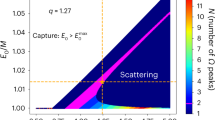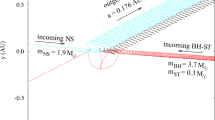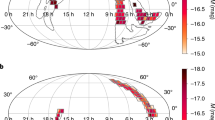Abstract
The origin of black hole mergers discovered by the LIGO1 and Virgo2 gravitational-wave observatories is currently unknown. GW1905213,4 is the heaviest black hole merger detected so far. Its observed high mass and possible spin-induced orbital precession could arise from the binary having formed following a close encounter. An observational signature of close encounters is eccentric binary orbit5,6,7; however, this feature is currently difficult to identify due to the lack of suitable gravitational waveforms. No eccentric merger has been previously found8. Here we report 611 numerical relativity simulations covering the full eccentricity range and an estimation approach to probe the eccentricity of mergers. Our set of simulations corresponds to ~105 waveforms, comparable to the number used in gravitational-wave searches, albeit with coarser mass ratio and spin resolution. We applied our approach to GW190521 and found that it is most consistent with a highly eccentric (\(e=0.6{9}_{-0.22}^{+0.17}\); 90% credible level) merger within our set of waveforms. This interpretation is supported over a non-eccentric merger with >10 odds ratio if ≳10% of GW190521-like mergers are highly eccentric. Detectable orbital eccentricity would be evidence against an isolated binary origin, which is otherwise difficult to rule out on the basis of observed mass and spin9,10.
This is a preview of subscription content, access via your institution
Access options
Access Nature and 54 other Nature Portfolio journals
Get Nature+, our best-value online-access subscription
$29.99 / 30 days
cancel any time
Subscribe to this journal
Receive 12 digital issues and online access to articles
$119.00 per year
only $9.92 per issue
Buy this article
- Purchase on Springer Link
- Instant access to full article PDF
Prices may be subject to local taxes which are calculated during checkout


Similar content being viewed by others
Data availability
Numerical relativity waveforms generated for and used in this study will be accessible at http://ccrg.rit.edu/~RITCatalog. Data generated by our calculations are available in Supplementary Information or are available from the corresponding authors upon reasonable request.
Code availability
The computer code that was used for the calculations is available from the corresponding authors upon reasonable request.
References
Aasi, J. et al. Advanced LIGO. Class. Quantum Grav. 32, 074001 (2015).
Acernese, F. et al. Advanced Virgo: a second-generation interferometric gravitational wave detector. Class. Quantum Grav. 32, 024001 (2015).
Abbott, R. et al. GW190521: a binary black hole merger with a total mass of 150 M⨀. Phys. Rev. Lett. 125, 101102 (2020).
Abbott, R. et al. Properties and astrophysical implications of the 150 M⊙ binary black hole merger GW190521. Astrophys. J. Lett. 900, L13 (2020).
Gondán, L., Kocsis, B., Raffai, P. & Frei, Z. Eccentric black hole gravitational-wave capture sources in galactic nuclei: distribution of binary parameters. Astrophys. J. 860, 5 (2018).
Samsing, J. Eccentric black hole mergers forming in globular clusters. Phys. Rev. D 97, 103014 (2018).
Samsing, J. et al. Active galactic nuclei as factories for eccentric black hole mergers. Preprint at https://arxiv.org/abs/2010.09765 (2020).
Abbott, B. P. et al. Search for eccentric binary black hole mergers with Advanced LIGO and Advanced Virgo during their first and second observing runs. Astrophys. J. 883, 149 (2019).
Gerosa, D. et al. Spin orientations of merging black holes formed from the evolution of stellar binaries. Phys. Rev. D 98, 084036 (2018).
Bavera, S. S. et al. The origin of spin in binary black holes. Predicting the distributions of the main observables of Advanced LIGO. Astron. Astrophys. 635, A97 (2020).
Gualandris, A., Colpi, M., Portegies Zwart, S. & Possenti, A. Has the black hole in XTE J1118+480 experienced an asymmetric natal kick? Astrophys. J. 618, 845–851 (2005).
Silsbee, K. & Tremaine, S. Lidov–Kozai cycles with gravitational radiation: merging black holes in isolated triple systems. Astrophys. J. 836, 39 (2017).
Liu, B., Lai, D. & Wang, Y.-H. Black hole and neutron star binary mergers in triple systems. II. Merger eccentricity and spin–orbit misalignment. Astrophys. J. 881, 41 (2019).
Hoang, B.-M., Naoz, S., Kocsis, B., Rasio, F. A. & Dosopoulou, F. Black hole mergers in galactic nuclei induced by the eccentric Kozai–Lidov effect. Astrophys. J. 856, 140 (2018).
Ireland, B., Birnholtz, O., Nakano, H., West, E. & Campanelli, M. Eccentric binary black holes with spin via the direct integration of the post-Newtonian equations of motion. Phys. Rev. D 100, 024015 (2019).
Lange, J., O’Shaughnessy, R. & Rizzo, M. Rapid and accurate parameter inference for coalescing, precessing compact binaries. Preprint at https://arxiv.org/abs/1805.10457 (2018).
Lange, J. et al. Parameter estimation method that directly compares gravitational wave observations to numerical relativity. Phys. Rev. D 96, 104041 (2017).
Salemi, F. et al. Wider look at the gravitational-wave transients from GWTC-1 using an unmodeled reconstruction method. Phys. Rev. D 100, 042003 (2019).
Nitz, A. H. & Capano, C. D. GW190521 may be an intermediate-mass ratio inspiral. Astrophys. J. Lett. 907, L9 (2021).
Abbott, R. et al. GWTC-2: compact binary coalescences observed by LIGO and Virgo during the first half of the third observing run. Phys. Rev. X 11, 021053 (2021).
Sadiq, J., Zlochower, Y., O’Shaughnessy, R. & Lange, J. Hybrid waveforms for generic precessing binaries for gravitational-wave data analysis. Phys. Rev. D 102, 024012 (2020).
Rodriguez, C. L. et al. Post-Newtonian dynamics in dense star clusters: formation, masses, and merger rates of highly-eccentric black hole binaries. Phys. Rev. D 98, 123005 (2018).
Cholis, I. et al. Orbital eccentricities in primordial black hole binaries. Phys. Rev. D 94, 084013 (2016).
Gayathri, V., Yang, Y., Tagawa, H., Haiman, Z. & Bartos, I. Black hole mergers of AGN origin in LIGO–Virgo’s O1–O3a observing periods. Astrophys. J. Lett. 920, L42 (2021).
Belczynski, K. et al. Evolutionary roads leading to low effective spins, high black hole masses, and O1/O2 rates for LIGO/Virgo binary black holes. Astron. Astrophys. 636, A104 (2020).
Gerosa, D., Kesden, M., Sperhake, U., Berti, E. & O’Shaughnessy, R. Multi-timescale analysis of phase transitions in precessing black-hole binaries. Phys. Rev. D 92, 064016 (2015).
Ramos-Buades, A., Tiwari, S., Haney, M. & Husa, S. Impact of eccentricity on the gravitational-wave searches for binary black holes: high mass case. Phys. Rev. D 102, 043005 (2020).
East, W. E., McWilliams, S. T., Levin, J. & Pretorius, F. Observing complete gravitational wave signals from dynamical capture binaries. Phys. Rev. D 87, 043004 (2013).
Bustillo, J. C., Sanchis-Gual, N., Torres-Forné, A. & Font, J. A. Confusing head-on collisions with precessing intermediate-mass binary black hole mergers. Phys. Rev. Lett. 126, 201101 (2021).
Romero-Shaw, I., Lasky, P. D., Thrane, E. & Calderón Bustillo, J. GW190521: orbital eccentricity and signatures of dynamical formation in a binary black hole merger signal. Astrophys. J. Lett. 903, L5 (2020).
Lower, M. E., Thrane, E., Lasky, P. D. & Smith, R. Measuring eccentricity in binary black hole inspirals with gravitational waves. Phys. Rev. D 98, 083028 (2018).
Estellés, H. et al. A detailed analysis of GW190521 with phenomenological waveform models. Preprint at https://arxiv.org/abs/2105.06360 (2021).
Nitz, A. H. et al. 3-OGC: catalog of gravitational waves from compact-binary mergers. Astrophys. J. 922, 76 (2021).
Fishbach, M. & Holz, D. E. Minding the gap: GW190521 as a straddling binary. Astrophys. J. Lett. 904, L26 (2020).
Zlochower, Y., Baker, J. G., Campanelli, M. & Lousto, C. O. Accurate black hole evolutions by fourth-order numerical relativity. Phys. Rev. D 72, 024021 (2005).
Campanelli, M., Lousto, C. O., Marronetti, P. & Zlochower, Y. Accurate evolutions of orbiting black-hole binaries without excision. Phys. Rev. Lett. 96, 111101 (2006).
Nakamura, T., Oohara, K. & Kojima, Y. General relativistic collapse to black holes and gravitational waves from black holes. Prog. Theor. Phys. Suppl. 90, 1–218 (1987).
Shibata, M. & Nakamura, T. Evolution of three-dimensional gravitational waves: harmonic slicing case. Phys. Rev. D 52, 5428 (1995).
Baumgarte, T. W. & Shapiro, S. L. Numerical integration of Einstein’s field equations. Phys. Rev. D 59, 024007 (1998).
Lousto, C. O. & Zlochower, Y. Foundations of multiple black hole evolutions. Phys. Rev. D 77, 024034 (2008).
Zlochower, Y., Ponce, M. & Lousto, C. O. Accuracy issues for numerical waveforms. Phys. Rev. D 86, 104056 (2012).
Healy, J. & Lousto, C. O. Remnant of binary black-hole mergers: new simulations and peak luminosity studies. Phys. Rev. D 95, 024037 (2017).
Healy, J., Lousto, C. O., Zlochower, Y. & Campanelli, M. The RIT binary black hole simulations catalog. Class. Quantum Grav. 34, 224001 (2017).
Healy, J. et al. The second RIT binary black hole simulations catalog and its application to gravitational waves parameter estimation. Phys. Rev. D 100, 024021 (2019).
Healy, J. & Lousto, C. O. Third RIT binary black hole simulations catalog. Phys. Rev. D 102, 104018 (2020).
Löffler, F. et al. The Einstein Toolkit: a community computational infrastructure for relativistic astrophysics. Class. Quantum Grav. 29, 115001 (2012).
Schnetter, E., Hawley, S. H. & Hawke, I. Evolutions in 3D numerical relativity using fixed mesh refinement. Class. Quantum Grav. 21, 1465–1488 (2004).
Brandt, S. & Brügmann, B. A simple construction of initial data for multiple black holes. Phys. Rev. Lett. 78, 3606–3609 (1997).
Ansorg, M., Brügmann, B. & Tichy, W. A single-domain spectral method for black hole puncture data. Phys. Rev. D 70, 064011 (2004).
Healy, J., Lousto, C. O., Nakano, H. & Zlochower, Y. Post-Newtonian quasicircular initial orbits for numerical relativity. Class. Quantum Grav. 34, 145011 (2017).
Nakano, H., Healy, J., Lousto, C. O. & Zlochower, Y. Perturbative extraction of gravitational waveforms generated with numerical relativity. Phys. Rev. D 91, 104022 (2015).
Campanelli, M., Lousto, C. O., Nakano, H. & Zlochower, Y. Comparison of numerical and post-Newtonian waveforms for generic precessing black-hole binaries. Phys. Rev. D 79, 084010 (2009).
Reisswig, C. & Pollney, D. Notes on the integration of numerical relativity waveforms. Class. Quantum Grav. 28, 195015 (2011).
Hannam, M. et al. Simple model of complete precessing black-hole-binary gravitational waveforms. Phys. Rev. Lett. 113, 151101 (2014).
Campanelli, M., Lousto, C. O., Nakano, H. & Zlochower, Y. Comparison of numerical and post-Newtonian waveforms for generic precessing black-hole binaries. Phys. Rev. D 79, 084010 (2009).
Lousto, C. O., Nakano, H., Zlochower, Y. & Campanelli, M. Intermediate-mass-ratio black-hole binaries: numerical relativity meets perturbation theory. Phys. Rev. Lett. 104, 211101 (2010).
Lovelace, G. et al. Modeling the source of GW150914 with targeted numerical-relativity simulations. Class. Quantum Grav. 33, 244002 (2016).
Healy, J. et al. Targeted numerical simulations of binary black holes for GW170104. Phys. Rev. D 97, 064027 (2018).
Healy, J., Lousto, C. O., Lange, J. & O’Shaughnessy, R. Application of the third RIT binary black hole simulations catalog to parameter estimation of gravitational-wave signals from the LIGO–Virgo O1 and O2 observational runs. Phys. Rev. D 102, 124053 (2020).
Fishbach, M., Farr, W. M. & Holz, D. E. The most massive binary black hole detections and the identification of population outliers. Astrophys. J. Lett. 891, L31 (2020).
Varma, V. et al. Surrogate models for precessing binary black hole simulations with unequal masses. Phys. Rev. Res. 1, 033015 (2019).
Acknowledgements
We thank C. Belczynski, E. Katsavounidis, A. Loeb and S. Vitale for useful suggestions, and G. Vedovato for his valuable help with the cWB search algorithm and with the set-up of the cWB waveform consistency study. We gratefully acknowledge the US National Science Foundation (NSF) for financial support from grants PHY-1912632 (C.O.L., M.C., R.O.), PHY-1911796 (I.B.), PHY-1806165 (S.K.), PHY-1707946 (M.C.), ACI-1550436 (M.C.), AST-1516150 (M.C.), ACI-1516125 (M.C.), PHY-1726215 (M.C., C.O.L.), NASA TCAN grant 80NSSC18K1488 (M.C., R.O.), and the support of the Alfred P. Sloan Foundation (I.B.). This work used the Extreme Science and Engineering Discovery Environment (XSEDE) (allocation TG-PHY060027N), which is supported by NSF grant ACI-1548562 and Frontera projects PHY-20010 and PHY-20007. Computational resources were also provided by NewHorizons, BlueSky Clusters and Green Prairies at the Rochester Institute of Technology, which were supported by NSF grants PHY-0722703 (M.C., C.O.L.), DMS-0820923, AST-1028087 (M.C.), PHY-1229173 (M.C., C.O.L.) and PHY-1726215 (M.C., C.O.L.). We are grateful for computational resources provided by the Leonard E. Parker Center for Gravitation, Cosmology and Astrophysics at the University of Wisconsin—Milwaukee supported by NSF grant PHY-1626190. We also acknowledge the use of IUCAA LDG cluster Sarathi for the computational/numerical work. We also acknowledge the use of LDG clusters at CIT, LHO and LLO for the computational/numerical work. This research has made use of data, software and/or web tools obtained from the Gravitational Wave Open Science Center (https://www.gw-openscience.org), a service of LIGO Laboratory, the LIGO Scientific Collaboration and the Virgo Collaboration. LIGO is funded by the NSF. Virgo is funded by the French Centre National de Recherche Scientifique (CNRS), the Italian Istituto Nazionale della Fisica Nucleare (INFN) and the Dutch Nikhef, with contributions by Polish and Hungarian institutes.
Author information
Authors and Affiliations
Contributions
I.B and R.O. contributed to the origination of the idea. J.H., J.L., C.O.L., M.C. and R.O. carried out the numerical relativity simulations and the Rochester Institute of Technology sensitivity studies. V.G., B.O., M.S., S.K. and I.B. carried out the cWB consistency check. All authors worked out collaboratively the general details of the project. V.G. created the figures with input from all other authors. All authors helped edit the manuscript.
Corresponding authors
Ethics declarations
Competing interests
The authors declare no competing interests.
Peer review
Peer review information
Nature Astronomy thanks Maya Fishbach and the other, anonymous, reviewer(s) for their contribution to the peer review of this work.
Additional information
Publisher’s note Springer Nature remains neutral with regard to jurisdictional claims in published maps and institutional affiliations.
Supplementary information
Supplementary Information
Supplementary Figs. 1–6 and Tables 1–3.
Rights and permissions
About this article
Cite this article
Gayathri, V., Healy, J., Lange, J. et al. Eccentricity estimate for black hole mergers with numerical relativity simulations. Nat Astron 6, 344–349 (2022). https://doi.org/10.1038/s41550-021-01568-w
Received:
Accepted:
Published:
Issue Date:
DOI: https://doi.org/10.1038/s41550-021-01568-w
This article is cited by
-
GW190521 as a dynamical capture of two nonspinning black holes
Nature Astronomy (2022)
-
AGN as potential factories for eccentric black hole mergers
Nature (2022)
-
General-relativistic precession in a black-hole binary
Nature (2022)



